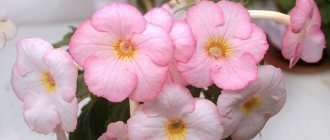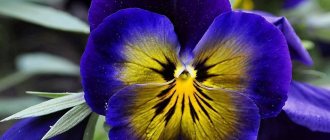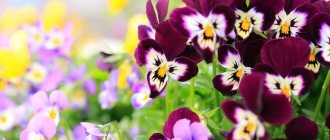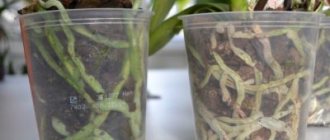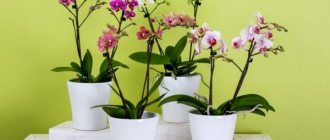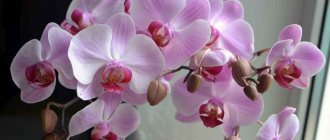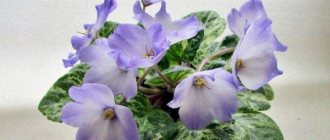Description and features
Miltonia is a sympodial epiphytic orchid. This means that in nature it lives on trees, has pronounced aerial roots, and forms lateral shoots with pseudobulbs for independent reproduction.
Miltonia leaves are long and belt-shaped. The color is not typical for orchids - grayish or yellowish. Flowers come in a variety of colors, sometimes combining several contrasting colors. The petals often have a pattern resembling the wings of butterflies.
An adult miltonia can throw out several peduncles at once, covered with blossoming flowers and buds. Flower growers often call miltonia pansies for their similarity in shape and color.
How to create optimal conditions for miltonia?
Although the orchids that gardeners have to deal with are, as a rule, more or less adapted to the conditions of modern homes, you need to try to create for them the microclimate to which they are accustomed in their historical homeland.
To avoid infection by fungi and other diseases, the room in which miltonia is located should be well ventilated, remembering that this plant does not tolerate drafts.
Table: recommendations for creating the right microclimate
| Criterion | Recommendations |
| Lighting | Diffused light for 10–12 hours or partial shade. East or west windows are best suited for placing miltonias. In the south, shading is necessary. Exposure to direct sunlight causes burns in the form of gray spots. Miltonia can be placed on a north window only with additional artificial lighting. In winter, additional lighting is required. Normally, the leaves are light, with a pinkish tint. If they darken, it means there is not enough light. |
| Air humidity | In nature, the figure reaches 80%. Therefore, the humidity in the room should be at least 50% (this is the “survival threshold”). You can provide a comfortable environment by using special humidifiers or placing a container of water next to the flower. Place wet moss, wet pebbles or expanded clay into the tray of the pot. It is not the orchids themselves that are sprayed, but the air around the flower. Moisture on the plant can cause rotting and spots on the petals. There is an opinion that spraying in the morning is desirable, but with the condition of subsequent removal of undried drops. |
| Temperature | Miltonia is a moderately heat-loving plant. The most comfortable temperature for it is on average 20–23ºС in summer and 15–18ºС in winter, with a mandatory daily difference of approximately 3–6ºС. In this case, sharp temperature fluctuations should not be allowed. In extreme heat, additional moisture is required. But there are Miltonias that “stand out” from this regime, for example, the brilliant one, which “likes it hot.” |
Interesting varieties
In total there are about 20 varieties of miltonia. Not all received distribution. The following types are most often found in apartments.
- Brilliant. Pseudobulbs are slightly elongated, flattened. The leaves are belt-shaped, yellowish in color. A fairly unpretentious variety - it can easily withstand heat and cold. It blooms with large white flowers with a yellowish tint. Less common is a pinkish color with purple streaks. Flowering occurs at the end of summer.
- Yellowish. A variety of Miltonia native to Argentina. Pseudobulbs bifoliate. Up to 14–15 large flowers bloom on one peduncle. The color is yellowish-white, often with a contrasting pattern. Blooms for a long time - from the beginning of spring almost until autumn.
- Snow-white. The pseudobulb produces one or two peduncles. Up to five flowers bloom on each peduncle. It has a pleasant aroma.
- Regnelli. Feature: thin glossy leaves. The flowers are large, white, fragrant. Each peduncle bears up to six flowers. The pink lip with purple stripes stands out clearly.
An interesting hybrid of Brassia and Miltonia deserves special attention. They called it Miltassia. It is distinguished by fancy elongated petals. From a distance, miltassia flowers resemble not fluttering butterflies, but spiders with long legs.
Varieties grown at home
Compared to other orchids, very few Miltonia species are currently known. The genus includes about two dozen “natural” orchids, 7–10 “natural” hybrids, including interspecific ones (such as Miltassia - the result of crossing Miltonia and Brassia), as well as about 40 breeding achievements. "True" miltonias are considered an endangered species. Therefore, mostly adapted plants from nurseries and selection hybrids go on sale. Most often in the homes of flower growers you can find the following types:
- Miltonia is brilliant or noticeable (spectabilis). It is distinguished by its endurance - it tolerates temperatures that are too high and too low for an orchid relatively painlessly. The pseudobulbs are noticeably flattened laterally, which is why they appear elongated. Lime colored leaves. The flowers are 6–8 cm in diameter. The petals are white, with a slight lilac or pinkish tint, covered with a pattern of bright crimson or purple veins. Peak flowering occurs in mid to late summer.
- Miltonia yellowish (flavescens). What is atypical for these orchids is that they “live” in Argentina. Each pseudobulb has two leaves. The peduncle bears 12–15 buds. The petals are narrow, straw-colored. The beginning of flowering can occur at any time from March to August.
- Miltonia white (candida). It is low maintenance. Flowering most often occurs in autumn. Each pseudobulb produces 1–2 peduncles with 4–6 buds. The shade of the petals varies from chocolate to yellowish-brown, the edges are corrugated. It is characterized by a pattern of small brick-colored specks. The species received its name due to its snow-white lip, which stands out effectively against the general background (a pink or crimson spot at its base is normal). Flower diameter is 8–10 cm.
- Miltonia Regnelli (regnellii), sometimes incorrectly called "Miltonia Regnell". It has very decorative leaves - thin, glossy. Each peduncle, about 0.5 m high, has 5–6 buds. The petals are snow-white, the lip is lilac, with a pattern of darker strokes. “Forgiving” to minor mistakes in care.
- Close's Miltonia (clowesi). Strongly resembles white miltonia. There are 7–10 buds in an inflorescence. The peduncle is quite tall - up to 45 cm. The petals are dull yellow with a pattern of dark brown strokes and stripes. The base of the lip is inky purple, then this color abruptly turns white. It is shaped like a guitar.
- Miltony Varshevich (wascewiezii). Unlike most miltonias, it blooms in winter or early spring. Inflorescences in the shape of a brush or broom. The petals are corrugated, brick-colored, with a yellowish or creamy tip. The lip is quite wide, deep purple, with a white border.
- Miltonia hybrid (hybrida). Each pseudobulb, 7–10 cm long, has two leaves (20–30 cm). The inflorescence is in the shape of a loose brush, bearing 3–5 buds. The petals are colored in different shades of red and pink. They are velvety to the touch. The flowers are almost flat, the lip is wide, oval. They resemble violets, but are much larger (7–8 cm in diameter).
- Miltonia moth is a hybrid. Currently, most botanists, taking into account the single-leaf pseudobulbs and the specific structure of the flower, classify it as miltoniopsis. The plant requires fairly cool indoor temperatures and a long dormant period. The flowers are about 5 cm in diameter, the petals are snow-white, with a pattern of yellow or scarlet strokes. The start of flowering extends from July to October.
- Miltonia Hudson Bay. Selective hybrid. The petals are white-purple, with a dark purple base. Covered with patterns of reddish stripes.
- Miltonia Red Tide. Large bright scarlet flowers, streaked with thin snow-white strokes.
- Miltonia Saint Heller. The petals are white and pink, with a bright crimson base.
Photo gallery: miltonias for home purchase
Miltonia resplendent is most often found on the window sills of flower growers.
Miltonia yellowish has petals of a very unusual straw color.
Miltonia snow-white owes its name to the lip of the corresponding shade.
Miltonia Renelia is able to “forgive” the grower for individual mistakes
Close's Miltonia differs from snow-white in having a more pronounced pattern on the petals
Miltonia Varshevich blooms in winter or early spring
The shade of Miltonia hybrid petals varies from soft pink to dark scarlet. Currently, most botanists classify Miltonia moth as a miltoniopsis.
Miltonia Hudson Bay is one of the most popular breeding hybrids Miltonia Red Tide is valued for its very large bright flowers
Miltonia Saint Heller - nothing special, just very delicate flowers
Features of caring for miltonia
How to care for miltonia? Like all orchids, miltonia requires special, careful care. When growing it, you need to adhere to a number of rules.
- Lighting. Compared to other types of orchids, it is less sensitive to light levels. Grows well in bright, indirect light on windowsills. It easily tolerates a little partial shade - miltonia can be placed slightly away from the window on tables and cabinets. Do not place it in the open sun - the leaves get burned, the flowers become discolored. In strong shade, growth slows down and flowering stops. The pinkish tint of miltonia leaves indicates that the lighting has been chosen correctly.
- Temperature. The optimal temperature for growing miltonia is 15-18°C in winter and 18-20°C in summer. These are recommended but not required settings. The orchid gradually adapts to the microclimate of the apartment and reacts normally to higher temperatures. Miltonia really does not like sudden temperature changes. The room is systematically ventilated, avoiding the formation of drafts.
- Humidity. Dry air and its stagnation have a detrimental effect on miltonia - the leaves dry out, the flowers fall off. It is recommended to maintain humidity at 65–80%. A special humidifier is installed next to the plant, and in winter the batteries are covered with a wet cloth. Spraying miltonia and the air around it has a good effect.
- Feeding. Fertilizers are applied mainly at the stage of bud formation and during flowering. Take a special product for orchids and reduce the concentration by half. Added every two weeks. You can feed miltonia in two ways - by watering at the root or spraying the leaves. Alternating these two methods gives a good effect.
- The soil. Miltonia needs special soil. It is made from crushed bark of coniferous trees, fern roots and peat. For looseness, add 5–10% polystyrene foam. You can use special soils for orchids.
- Transfer. Miltonia does not like unnecessary interventions - they try not to disturb the flower unless necessary. You can replant miltonia if the roots are breaking through the drainage holes or the soil has compacted and turned to dust. When replanting, the root system is carefully inspected and freed from the remnants of the old soil mixture. Roots that are too long are trimmed and diseased and dried out ones are removed. All sections are treated with charcoal powder.
- Container for planting. A large pot is not needed - miltonia prefers a slightly cramped environment. Unlike phalaenopsis, it is not necessary to use a transparent pot.
How to care for miltonia after transplantation? For the first ten days, the transplanted orchid is shaded from bright light. The first watering is carried out immediately after transplantation. For irrigation, use warm, settled water with the addition of a small amount of fertilizer. Watered using the immersion method - the pot is immersed in the nutrient mixture for about half an hour. After this, watering is stopped for two weeks. The next feeding is only in three weeks.
Plant transplantation procedure
Orchids do not like replanting, therefore, unless necessary (too small a pot, rotten roots, substrate that has lost its properties), this operation should not be repeated more often than once every 2-3 years. But there are exceptions, for example, miltonia resplendent, which must be replanted annually.
The best time to do this is in the spring, when the pseudobulbs begin to grow. The new container should not be too spacious; choose one that is only 2-3 cm larger in diameter than the old one. It is advisable to plant the orchid in a transparent pot - this allows you to control the condition of the substrate, roots, and promotes nutrition of the plant, since miltonia roots are involved in the process of photosynthesis .
You should not be afraid that the roots are sticking out of the pot, and because of this you should not rush to replant. Aerial roots are the norm for these orchids.
The bottom of the container in which your orchid will live must have holes over which a drainage layer (pebbles, expanded clay) is laid to facilitate water drainage. Disinfection is desirable - for this it is enough to treat the vessel well with boiling water.
If everything is prepared, you can start transplanting:
- Remove the miltonia from the old pot, being careful not to damage the roots. To facilitate the process, water the plant generously half an hour before.
- To clean the roots from the remnants of the old substrate, place them in water at a temperature of 35–37ºС.
- Remove rotten parts, from which liquid releases when lightly pressed, using a sharp knife. Sprinkle the sections with activated carbon powder. You can use antibiotics and fungicides, but not brilliant green or alcohol solutions: they cause burns followed by tissue death.
- To dry the roots, leave the plant for several hours in a warm room.
- Place the miltonia in the center of the pot and cover with substrate so that the soil covers only the roots, without interfering with the growth of leaves and pseudobulbs.
- Watering time depends on the condition of the roots. If they have dried well, then you can moisten the substrate almost immediately after transplanting. If not, then after 2-3 days.
Watering
Miltonia is watered abundantly only in the warm season, when it grows and blooms intensively. Excessive watering is avoided. Miltonia should be watered so that the substrate always remains moist. Drying out and stagnant moisture are equally destructive. Two methods of watering are used.
- By immersion. The most common watering method. The pot is placed in a basin with lukewarm water. The liquid should not fall on the substrate - water is poured into the basin just below the level of the edge of the pot. Keep in water until the substrate is completely saturated with moisture. Usually 15-20 minutes is enough. The pot is taken out, placed on a wire rack to drain excess liquid and the plant is returned to its place.
- Top watering. Miltonia is watered from a warm shower, simulating tropical rain. The optimal water temperature is 30-40°C. After the shower, dry the flower and remove any remaining moisture from the axils of the leaves.
In winter, water less often - only if absolutely necessary. During cool wintering, overhead watering is not used; watering is only done by immersion.
Flowering and dormant period
With good care, miltonia blooms twice a year. At the same time, the plant produces up to three peduncles with fragrant large flowers. Each hybrid Miltonia variety has its own shade and pattern.
Flowering lasts up to two months. Proper care of miltonia during flowering allows you to see new flower stalks on the plant after a couple of months of rest. During flowering, they try not to disturb miltonia unnecessarily; they regularly apply fertilizers. They protect from direct sun and try to maintain constant microclimate parameters.
Cut off flower stalks immediately after wilting. They cut almost to the root without injuring the pseudobulb. The orchid will rest for two months. Miltonia is transferred to a cool place and watering is reduced. After new flower stalks appear, they return to standard care.
Without a dormant period, miltonia will not form flower arrows. Lack of rest is one of the most common mistakes novice gardeners make.
How to care for crops at home
Most gardeners consider the plant to be very demanding in terms of care and breeding conditions. This position was formed due to its periodic shedding of buds or leaves. To protect yourself from unpleasant shedding, you need to keep the flower in an environment suitable for it.
The culture will grow 100% at home if it is placed in a cool room. Camellias do not like it when they are turned around relative to the light source or moved to another place. The flower prefers spaces with fresh air, with the exception of drafts. In this case, he will develop various diseases.
Subtleties of reproduction
Miltonia produces babies extremely rarely; pseudobulbs take root poorly, so it is propagated only by dividing the bush. Divide the bush at the same time as replanting. The flower at the time of division must be mature, healthy and have at least six pseudobulbs. The division is carried out in four stages.
- Miltonia is removed from the pot, and the remaining soil is removed from the roots.
- Use a sharp sterile knife to cut the bush. On each division, three pseudobulbs and a formed root system are left. The sections are treated with charcoal powder.
- The delenki are left to dry for five hours, then they can be planted in separate pots. Do not deepen the roots too deeply - this is fraught with the development of rot.
- In the first three weeks, moderate watering is maintained. Restrained growth of miltonia in the first weeks after division is normal.
Dividing miltonia too often is not recommended. Large bushes develop better, bloom more profusely, and are less susceptible to diseases and pests.
Fertilizers for Miltonia
Complex mineral fertilizers contain a certain set of micro- and macroelements in different concentrations. Each of these substances is responsible for certain processes. A deficiency or excess of this affects the appearance of the plant, the intensity of flowering and growth. In the table you can familiarize yourself with all the substances vital for miltonia, their role in the life of the flower, signs of deficiency or excess.
Table - Substances necessary for miltonia
| Substance | Its functions | a lack of | Excess |
| Nitrogen | — Synthesis of protein compounds; — active growth | — Shredding, lethargy of leaves; - yellow, marbled leaves; - accelerated drying of old foliage | — Very fast growth; - lack of flowering; - softening and cracking of the fabric |
| Phosphorus | — Regulation of cell division; - flowering; - seed ripening | — Weakening of the plant; - curvature of young shoots; - faded, reddish tint of leaves; - lack of flowering | - Blackening of leaf tips |
| Potassium | — Metabolism; - photosynthesis; — saturation of cells with moisture; - plant immunity | - General weakening; - growth arrest; - decrease in turgor; - dark green leaves with yellowish edging; - marbling | — Blockage of nitrogen supply (nitrogen deficiency) |
| Calcium | — Cell division; - root formation | — Weakening of plant tissues | — Deformation of new shoots |
| Magnesium | - Production of chlorophyll; - regulation of water flow | - Yellow spots that turn black over time | — Potassium deficiency |
| Iron | — Photosynthesis; - converting nitrogen into an easily digestible form | — Yellowing of the veins of young leaves; - spots on the leaves (veins are not affected); - dying of leaves from the edges; - slow growth | — Slowdown of development; - lack of flowering |
| Zinc | — Synthesis of enzymes and chlorophyll | — Not found in practice | — Marbling of leaves; - inhibition in development; - lack of flowering; - leaf deformation |
| Copper | — Formation of enzymes; - increased immunity | — Leaf curvature; - lack of flowering | — Growth slowdown; - reddish tint of leaves |
Judging by the reviews of experienced gardeners, you need to use only special fertilizers for orchids in half the dosage and strictly adhere to the feeding schedule.
Common care mistakes
Growing any orchid is a complex process that requires certain knowledge and skills. Beginners often make mistakes that lead to illness and loss of flower decorativeness. Information from the table will help determine what happened to miltonia.
Table - Consequences of improper care for miltonia
| Problem encountered | Probable Cause |
| Unopened buds fall | — Cold draft; - heat; - dry air |
| Flowering becomes short | — Short period of rest; - lack of nutrients; - heat; - action of the open sun |
| Miltonia leaves turn yellow | — Lack or excess of nutrients; - rotting of the root system |
| Black spots appear on pseudobulbs and leaves | — Regular waterlogging of the substrate in combination with cold or drafts |
| Leaves become pale | — Lack of nutrients; - excess light |
| The leaves are darkening | — Poor lighting |
| Leaves wither and wrinkle | - Narrow pot; - irregular watering |
| Small black spots appear | — Water stagnation |
| Light translucent spots appear | — Sunburn |
| The tips of the leaves dry out | — Soil salinization; - dry air |
An orchid can shed buds and leaves if ripe fruits lie next to it. Ripe apples, pears and bananas release ethylene into the air. This substance is very harmful to flowers.
Pests and diseases of camellias
Compared to other crops, such flowers practically do not get sick. Aphids may appear on a houseplant, which are usually sprayed with a mixture of oil emulsions and soap. This solution is much safer for people than chemicals. In addition to aphids, such emulsions neutralize scale insects and spider mites. But the most serious ailment of camellia is root rotting due to waterlogging, unsuitable soil and elevated temperatures. With such a disease, the leaves of the flower begin to fall off. The only way to save the crop is by reducing watering.
Of course, many already know how beautiful and luxurious the Japanese camellia looks. Planting and caring for it will not be burdensome for anyone.
Major diseases
With good care, diseases do not occur very often. The slightest care errors weaken miltonia and make it susceptible to fungi and viruses. The table contains the main diseases that flower growers have to deal with, as well as their symptoms and treatment.
Table - Main diseases of miltonia
| Name of the disease | External manifestations | Treatment options |
| Leaf spot | — Elongated yellow spots that turn brown over time | - Cannot be treated (destroyed) |
| Bronzing of leaves | — Leaf deformation; - ugliness; - brown, randomly located spots | - Cannot be treated (destroyed) |
| Rot of the stem base | — Whitening and rot of the pseudobulb | — Diseased pseudobulbs are removed; - cut out diseased areas, treat the sections with coal powder and fungicide; - transplanted |
| Fusarium rot | — Fading and yellowing of individual leaves; - whitish with a pink tint on the root collar | — Replant with cutting out damaged areas; - repeatedly treated with fungicides |
| Anthracnose | - Dark sunken spots | — Cut out the affected areas; - treated with fungicides; - temporarily reduce air humidity |
| Leaf spot | — Black-brown spots of small size; - yellowing of leaves | — Cut out diseased parts of the plant; - miltonia is dried and replanted |
| Gray rot | - Flowers become speckled; - softness and wateriness of tissues; - moldy gray coating | — Remove the affected areas; - temporarily reduce humidity - treat with fungicides |
| Bacterial rot | — Fading and rotting of leaves | Not subject to treatment (destroyed) |
| Late blight | — Withering and drying of individual parts of the plant; - rot from the base of the stem | — Diseased areas are cut out and treated with fungicides (the likelihood of recovery is very low) |
| Root rot | — Dullness and pale color of leaves; - softening, rotting of roots; - “frayed” roots | — Replant with removal of the affected parts; - reduce watering; - repeated treatment with fungicides |
| Brown rot (Only young plants up to several weeks old are affected) | — Thinning, browning of the base of the stem | - Cannot be treated (destroyed) |
| Cercospora | — Yellow spots along the edge of the reverse side of the sheet; - addition of black, purple, red-brown spots; - falling of diseased leaves | — Affected leaves are removed; - limit watering; - reduce air humidity; - sprayed with Mancozeb fungicide |
Reanimation of an orchid without roots
Before proceeding with rescue, be sure to first eliminate the reasons that led to the need for resuscitation. The likelihood of success is greater if a young plant is affected.
Resuscitation begins with the removal of all damaged and dead parts of the plant. Then - treatment of the sections with crushed activated carbon, colloidal sulfur, any powdered antibiotics and fungicides.
Mini-greenhouses cannot be used to save miltonias, since these orchids cannot tolerate stagnant air. But you can try to do this in a regular plastic glass. To do this, a small layer of pebbles or expanded clay is poured onto the bottom of the container, and wet sphagnum moss is placed on top. The plant can be lightly powdered with Kornevin in the place where the roots should be.
Place the orchid on sphagnum with the sprout facing up. Moss must be sprayed regularly to maintain its moisture. Once every 10–20 days, the plant can be soaked in a weak solution of complex fertilizer (with a nitrogen content of no more than 14%). It is also possible to use growth stimulants, for example, Epin, Zircon (1 drop per liter of water), but not more than once a month.
An orchid that has lost its roots can be soaked daily in a container of water for 3–4 hours, adding a weak solution of a growth stimulator (succinic acid) once a week. When the first roots appear, feeding is stopped and the stay in water is increased to 6 hours. All you have to do is wait until they grow to about 5 cm and plant the plant in a pot. If, due to insufficient development of the roots, the orchid “dangles”, then it must be secured with a support. The plant is provided with a temperature of 18–24ºС and good lighting.
Rescued miltonias are soaked in water with the addition of succinic acid - this is a powerful growth stimulant.
Typical pests
Miltonia is attacked by the same pests as other types of orchids. Their appearance is provoked by dry air, proximity to infected plants, and violation of care conditions. Most of them feed on the sap of the plant, which leads to its weakening. Information about the main pests and methods of controlling them is given in the table.
Table - Main pests of Miltonia
| Pest | How to detect | What to do |
| Thrips | — Uneven yellowish-white coloring of individual sections of leaves; - insect secretions in the form of dark dots; - drying and falling of leaves; - dried spots on the edges of the petals | — Repeated treatment with the preparations “Aktara”, “Fufanon”, “Iskra”, “Tanrek” |
| Spider mite | - Yellow specks; - large faded areas; - cobwebs on the back of leaves | — Treatment with soap solution or mineral oil; — increase in humidity; — treatment with acaricides “Akarin”, “Vermitek”, “Molniya” |
| Shields | - Light spots on the leaves; — insects in brown scutes; - transparent sticky coating; - secondary attachment of sooty fungus | — Lubricating areas with insects with vegetable oil; — manual removal of insects; - treatment with Actellik or Karbofos |
| Chervetsy | — Waxy discharge on petioles and veins | — Spraying with mineral oil |
| Aphids | - Sticky discharge; - curling and yellowing of young leaves | — Washing with soapy water; - spraying with infusion of tobacco dust or any insecticide |
If the roots have rotted...
Root rot is a problem not only for miltonia, but also for other types of orchids. It happens that the plant is left completely without roots. What to do in such cases? Is it possible to save miltonia? Below is a step-by-step description of the method for resuscitating miltonia roots. Proceed in five steps.
- Remove the orchid from the pot and remove any rotten roots.
- Immerse the miltonia rosette in a 2% solution of any fungicide for ten minutes.
- Dust all sections with charcoal powder or crushed chalk and leave to dry for five hours.
- Fill the container with warm water. Set miltonia in it for 6 hours. There is no need to completely immerse the flower in water - only its base should touch the liquid.
- After six hours, remove the miltonia and leave it to dry until the next morning.
This procedure must be repeated every morning until the length of the young roots reaches 4-5cm. After the roots grow, the reanimated miltonia is transplanted into the ground.
A little tip - add a little honey or sugar syrup to the water. This will significantly speed up the process of restoring the root system.
Growing miltonia at home is an excellent choice for beginners who have not yet had to deal with orchids. Compared to most types of orchids, miltonia is relatively unpretentious and resistant to diseases and pests.
More about the flower
Miltonia orchid has oval bulbs that produce leaves, peduncles and aerial roots, which in nature allow the flower to parasitize on trees. The leaves grow up to 35-40 centimeters in length and have a grayish-yellow color. Velvety flowers are formed on the peduncles, the diameter of which is 10-12 centimeters. The color of the petals is white, purple, pink, yellow, red. Many hybrids of this beautiful tropical beauty have been bred, and many flower growers dream of getting this crop into their home collection.
